Organizational Behaviour Report: M&S, Culture, Motivation and Teams
VerifiedAdded on 2023/01/13
|17
|5751
|22
Report
AI Summary
This report provides a comprehensive analysis of organizational behaviour within Marks & Spencer (M&S), a British retailer. It explores the influence of organizational culture, politics, and power dynamics on individual and team performance, highlighting how these factors impact employee motivation and the achievement of company goals. The report evaluates various motivational theories, including Maslow's Hierarchy of Needs and Herzberg's Hygiene Theory, and their application in influencing employee behaviour. It also examines the characteristics of effective versus ineffective teams, along with team and group development theories that support cooperation. Finally, the report discusses the concepts and philosophies of organizational behaviour within the M&S working environment, offering insights into how the company can foster a positive and productive workplace culture.
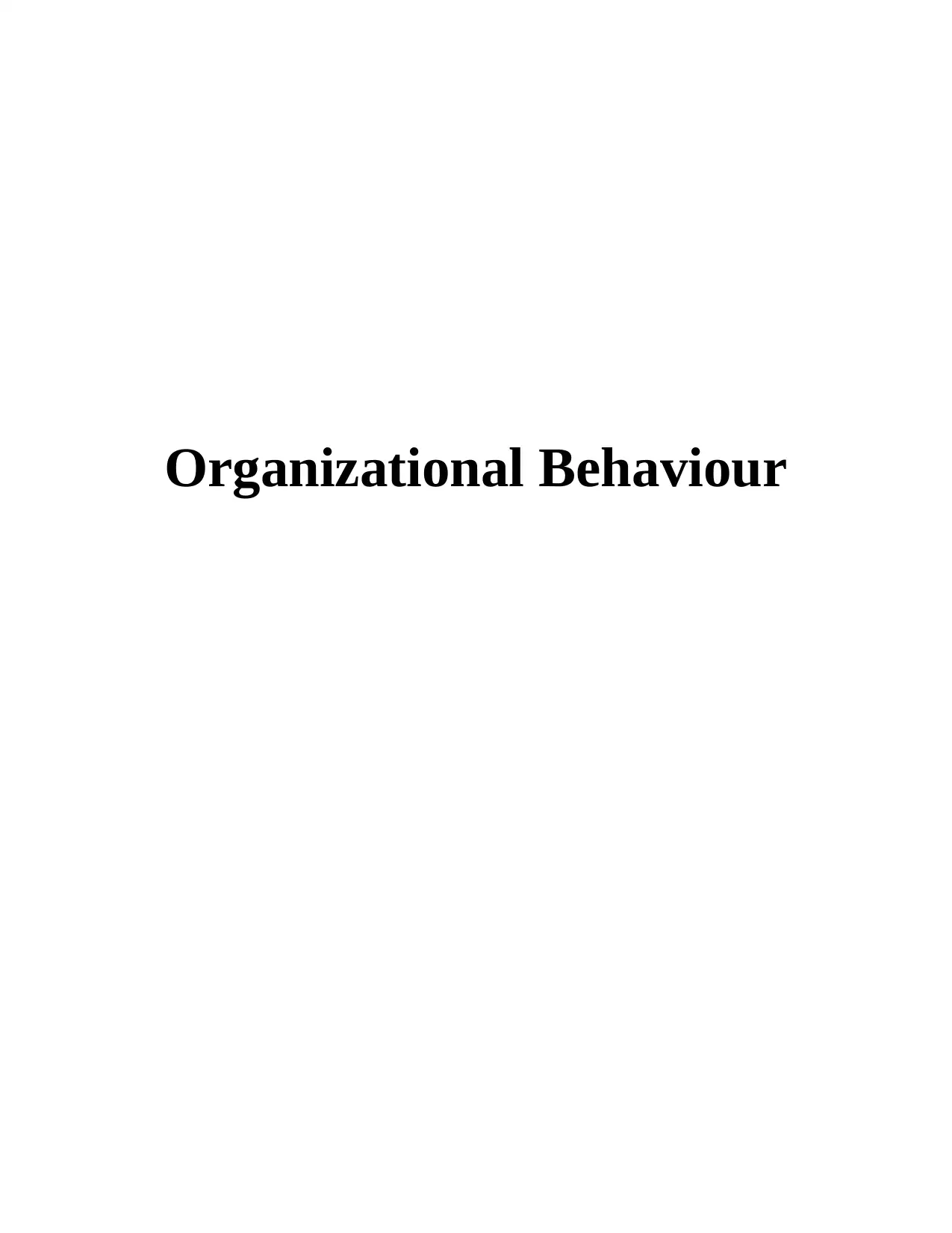
Organizational Behaviour
Paraphrase This Document
Need a fresh take? Get an instant paraphrase of this document with our AI Paraphraser
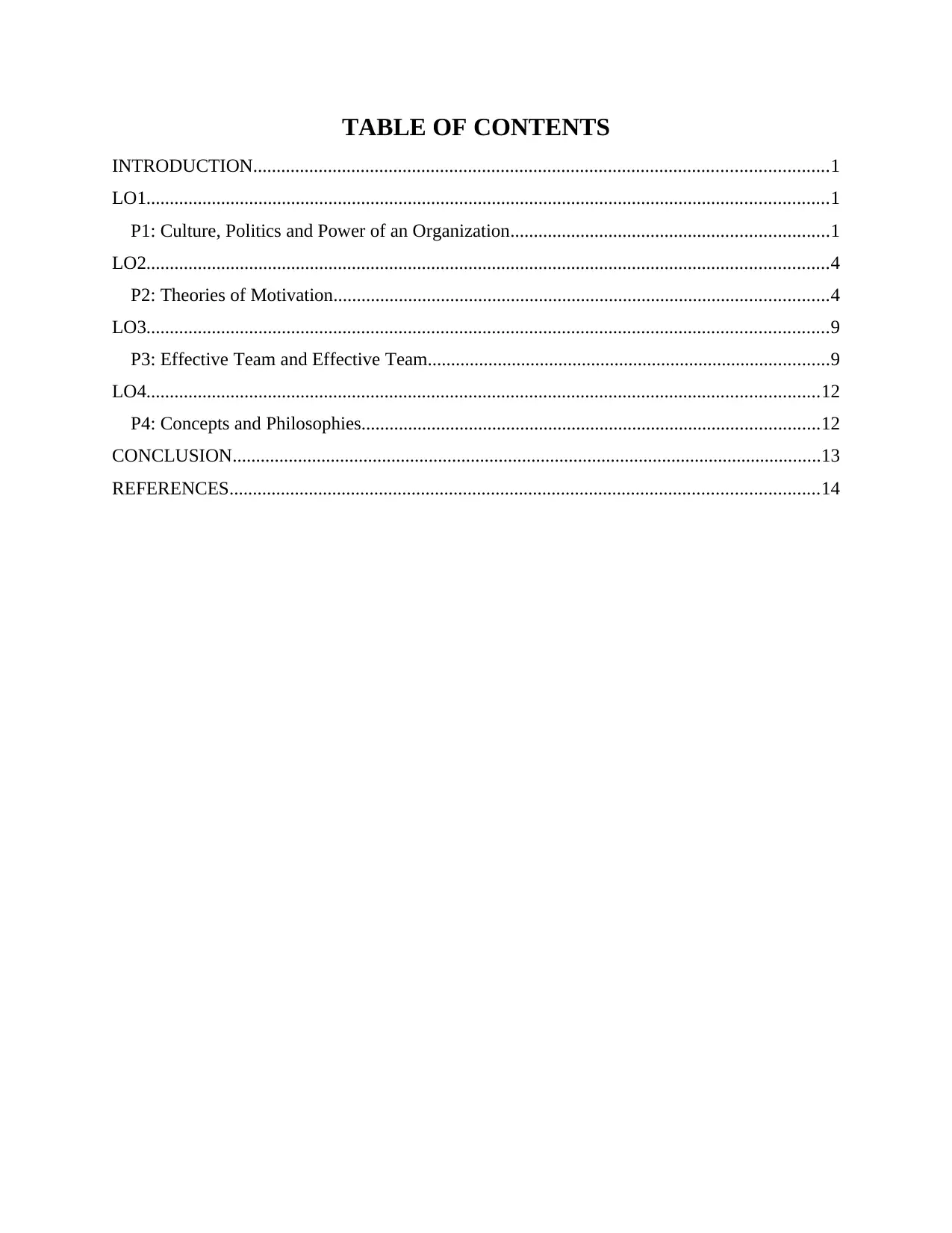
TABLE OF CONTENTS
INTRODUCTION...........................................................................................................................1
LO1..................................................................................................................................................1
P1: Culture, Politics and Power of an Organization....................................................................1
LO2..................................................................................................................................................4
P2: Theories of Motivation..........................................................................................................4
LO3..................................................................................................................................................9
P3: Effective Team and Effective Team......................................................................................9
LO4................................................................................................................................................12
P4: Concepts and Philosophies..................................................................................................12
CONCLUSION..............................................................................................................................13
REFERENCES..............................................................................................................................14
INTRODUCTION...........................................................................................................................1
LO1..................................................................................................................................................1
P1: Culture, Politics and Power of an Organization....................................................................1
LO2..................................................................................................................................................4
P2: Theories of Motivation..........................................................................................................4
LO3..................................................................................................................................................9
P3: Effective Team and Effective Team......................................................................................9
LO4................................................................................................................................................12
P4: Concepts and Philosophies..................................................................................................12
CONCLUSION..............................................................................................................................13
REFERENCES..............................................................................................................................14
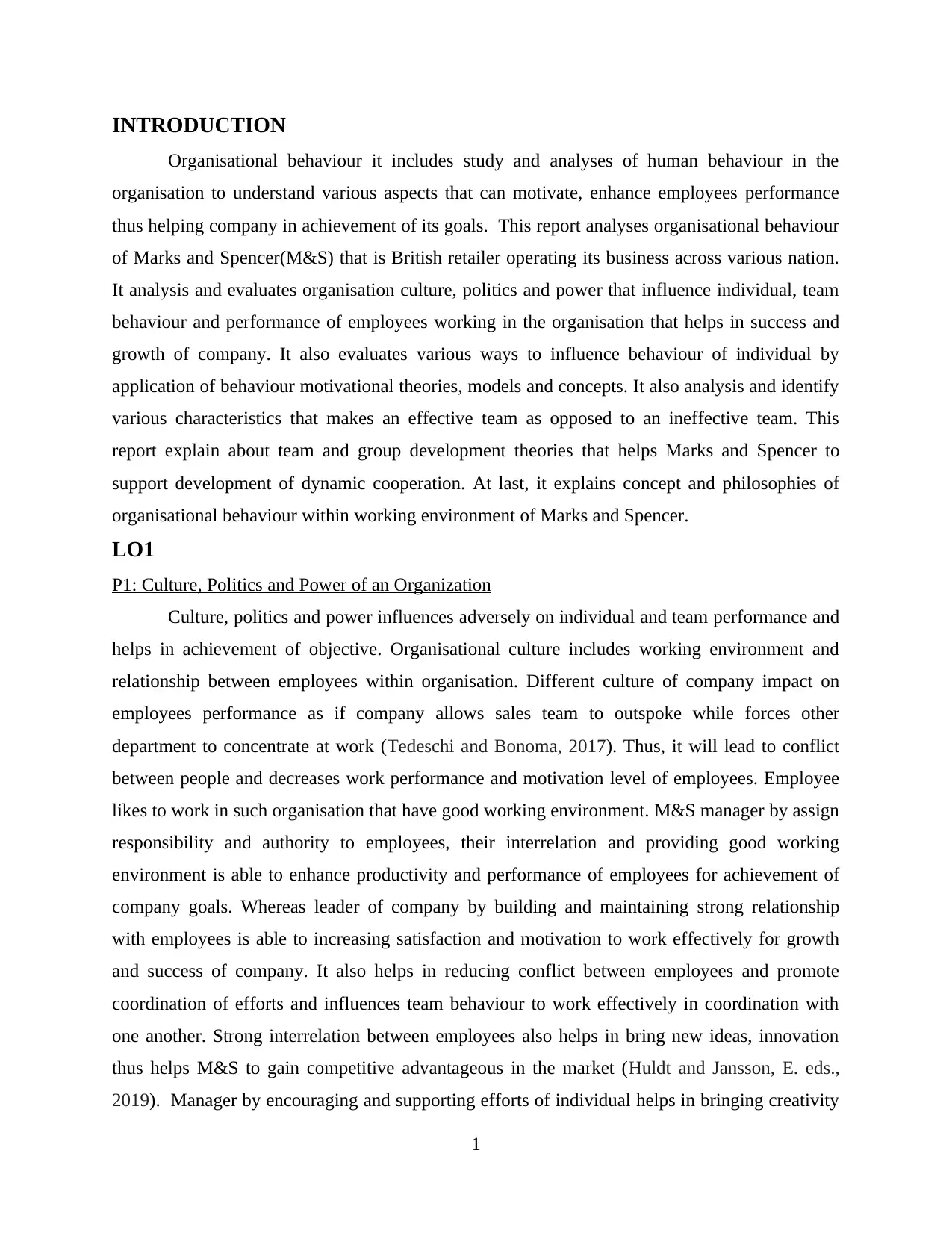
INTRODUCTION
Organisational behaviour it includes study and analyses of human behaviour in the
organisation to understand various aspects that can motivate, enhance employees performance
thus helping company in achievement of its goals. This report analyses organisational behaviour
of Marks and Spencer(M&S) that is British retailer operating its business across various nation.
It analysis and evaluates organisation culture, politics and power that influence individual, team
behaviour and performance of employees working in the organisation that helps in success and
growth of company. It also evaluates various ways to influence behaviour of individual by
application of behaviour motivational theories, models and concepts. It also analysis and identify
various characteristics that makes an effective team as opposed to an ineffective team. This
report explain about team and group development theories that helps Marks and Spencer to
support development of dynamic cooperation. At last, it explains concept and philosophies of
organisational behaviour within working environment of Marks and Spencer.
LO1
P1: Culture, Politics and Power of an Organization
Culture, politics and power influences adversely on individual and team performance and
helps in achievement of objective. Organisational culture includes working environment and
relationship between employees within organisation. Different culture of company impact on
employees performance as if company allows sales team to outspoke while forces other
department to concentrate at work (Tedeschi and Bonoma, 2017). Thus, it will lead to conflict
between people and decreases work performance and motivation level of employees. Employee
likes to work in such organisation that have good working environment. M&S manager by assign
responsibility and authority to employees, their interrelation and providing good working
environment is able to enhance productivity and performance of employees for achievement of
company goals. Whereas leader of company by building and maintaining strong relationship
with employees is able to increasing satisfaction and motivation to work effectively for growth
and success of company. It also helps in reducing conflict between employees and promote
coordination of efforts and influences team behaviour to work effectively in coordination with
one another. Strong interrelation between employees also helps in bring new ideas, innovation
thus helps M&S to gain competitive advantageous in the market (Huldt and Jansson, E. eds.,
2019). Manager by encouraging and supporting efforts of individual helps in bringing creativity
1
Organisational behaviour it includes study and analyses of human behaviour in the
organisation to understand various aspects that can motivate, enhance employees performance
thus helping company in achievement of its goals. This report analyses organisational behaviour
of Marks and Spencer(M&S) that is British retailer operating its business across various nation.
It analysis and evaluates organisation culture, politics and power that influence individual, team
behaviour and performance of employees working in the organisation that helps in success and
growth of company. It also evaluates various ways to influence behaviour of individual by
application of behaviour motivational theories, models and concepts. It also analysis and identify
various characteristics that makes an effective team as opposed to an ineffective team. This
report explain about team and group development theories that helps Marks and Spencer to
support development of dynamic cooperation. At last, it explains concept and philosophies of
organisational behaviour within working environment of Marks and Spencer.
LO1
P1: Culture, Politics and Power of an Organization
Culture, politics and power influences adversely on individual and team performance and
helps in achievement of objective. Organisational culture includes working environment and
relationship between employees within organisation. Different culture of company impact on
employees performance as if company allows sales team to outspoke while forces other
department to concentrate at work (Tedeschi and Bonoma, 2017). Thus, it will lead to conflict
between people and decreases work performance and motivation level of employees. Employee
likes to work in such organisation that have good working environment. M&S manager by assign
responsibility and authority to employees, their interrelation and providing good working
environment is able to enhance productivity and performance of employees for achievement of
company goals. Whereas leader of company by building and maintaining strong relationship
with employees is able to increasing satisfaction and motivation to work effectively for growth
and success of company. It also helps in reducing conflict between employees and promote
coordination of efforts and influences team behaviour to work effectively in coordination with
one another. Strong interrelation between employees also helps in bring new ideas, innovation
thus helps M&S to gain competitive advantageous in the market (Huldt and Jansson, E. eds.,
2019). Manager by encouraging and supporting efforts of individual helps in bringing creativity
1
⊘ This is a preview!⊘
Do you want full access?
Subscribe today to unlock all pages.

Trusted by 1+ million students worldwide
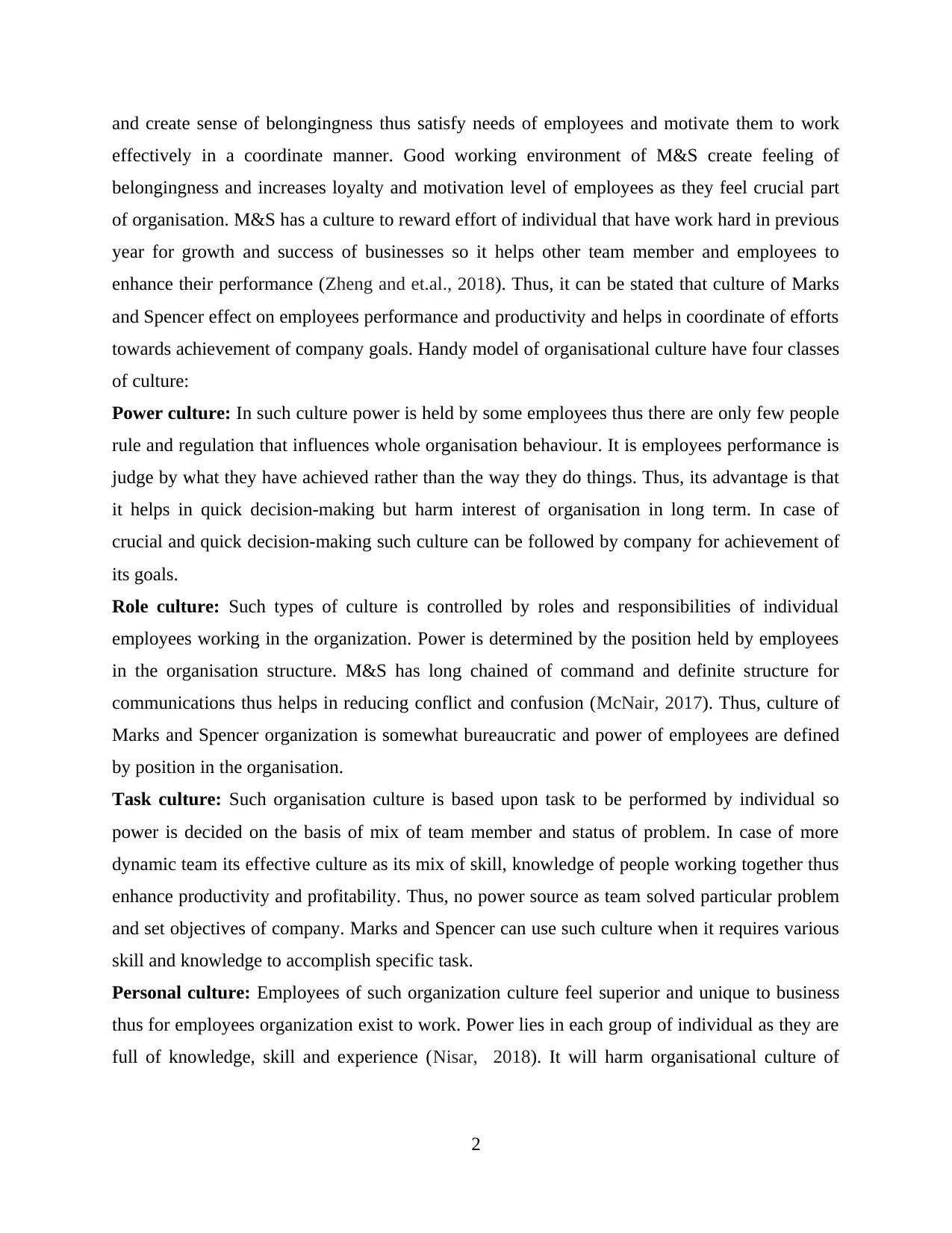
and create sense of belongingness thus satisfy needs of employees and motivate them to work
effectively in a coordinate manner. Good working environment of M&S create feeling of
belongingness and increases loyalty and motivation level of employees as they feel crucial part
of organisation. M&S has a culture to reward effort of individual that have work hard in previous
year for growth and success of businesses so it helps other team member and employees to
enhance their performance (Zheng and et.al., 2018). Thus, it can be stated that culture of Marks
and Spencer effect on employees performance and productivity and helps in coordinate of efforts
towards achievement of company goals. Handy model of organisational culture have four classes
of culture:
Power culture: In such culture power is held by some employees thus there are only few people
rule and regulation that influences whole organisation behaviour. It is employees performance is
judge by what they have achieved rather than the way they do things. Thus, its advantage is that
it helps in quick decision-making but harm interest of organisation in long term. In case of
crucial and quick decision-making such culture can be followed by company for achievement of
its goals.
Role culture: Such types of culture is controlled by roles and responsibilities of individual
employees working in the organization. Power is determined by the position held by employees
in the organisation structure. M&S has long chained of command and definite structure for
communications thus helps in reducing conflict and confusion (McNair, 2017). Thus, culture of
Marks and Spencer organization is somewhat bureaucratic and power of employees are defined
by position in the organisation.
Task culture: Such organisation culture is based upon task to be performed by individual so
power is decided on the basis of mix of team member and status of problem. In case of more
dynamic team its effective culture as its mix of skill, knowledge of people working together thus
enhance productivity and profitability. Thus, no power source as team solved particular problem
and set objectives of company. Marks and Spencer can use such culture when it requires various
skill and knowledge to accomplish specific task.
Personal culture: Employees of such organization culture feel superior and unique to business
thus for employees organization exist to work. Power lies in each group of individual as they are
full of knowledge, skill and experience (Nisar, 2018). It will harm organisational culture of
2
effectively in a coordinate manner. Good working environment of M&S create feeling of
belongingness and increases loyalty and motivation level of employees as they feel crucial part
of organisation. M&S has a culture to reward effort of individual that have work hard in previous
year for growth and success of businesses so it helps other team member and employees to
enhance their performance (Zheng and et.al., 2018). Thus, it can be stated that culture of Marks
and Spencer effect on employees performance and productivity and helps in coordinate of efforts
towards achievement of company goals. Handy model of organisational culture have four classes
of culture:
Power culture: In such culture power is held by some employees thus there are only few people
rule and regulation that influences whole organisation behaviour. It is employees performance is
judge by what they have achieved rather than the way they do things. Thus, its advantage is that
it helps in quick decision-making but harm interest of organisation in long term. In case of
crucial and quick decision-making such culture can be followed by company for achievement of
its goals.
Role culture: Such types of culture is controlled by roles and responsibilities of individual
employees working in the organization. Power is determined by the position held by employees
in the organisation structure. M&S has long chained of command and definite structure for
communications thus helps in reducing conflict and confusion (McNair, 2017). Thus, culture of
Marks and Spencer organization is somewhat bureaucratic and power of employees are defined
by position in the organisation.
Task culture: Such organisation culture is based upon task to be performed by individual so
power is decided on the basis of mix of team member and status of problem. In case of more
dynamic team its effective culture as its mix of skill, knowledge of people working together thus
enhance productivity and profitability. Thus, no power source as team solved particular problem
and set objectives of company. Marks and Spencer can use such culture when it requires various
skill and knowledge to accomplish specific task.
Personal culture: Employees of such organization culture feel superior and unique to business
thus for employees organization exist to work. Power lies in each group of individual as they are
full of knowledge, skill and experience (Nisar, 2018). It will harm organisational culture of
2
Paraphrase This Document
Need a fresh take? Get an instant paraphrase of this document with our AI Paraphraser
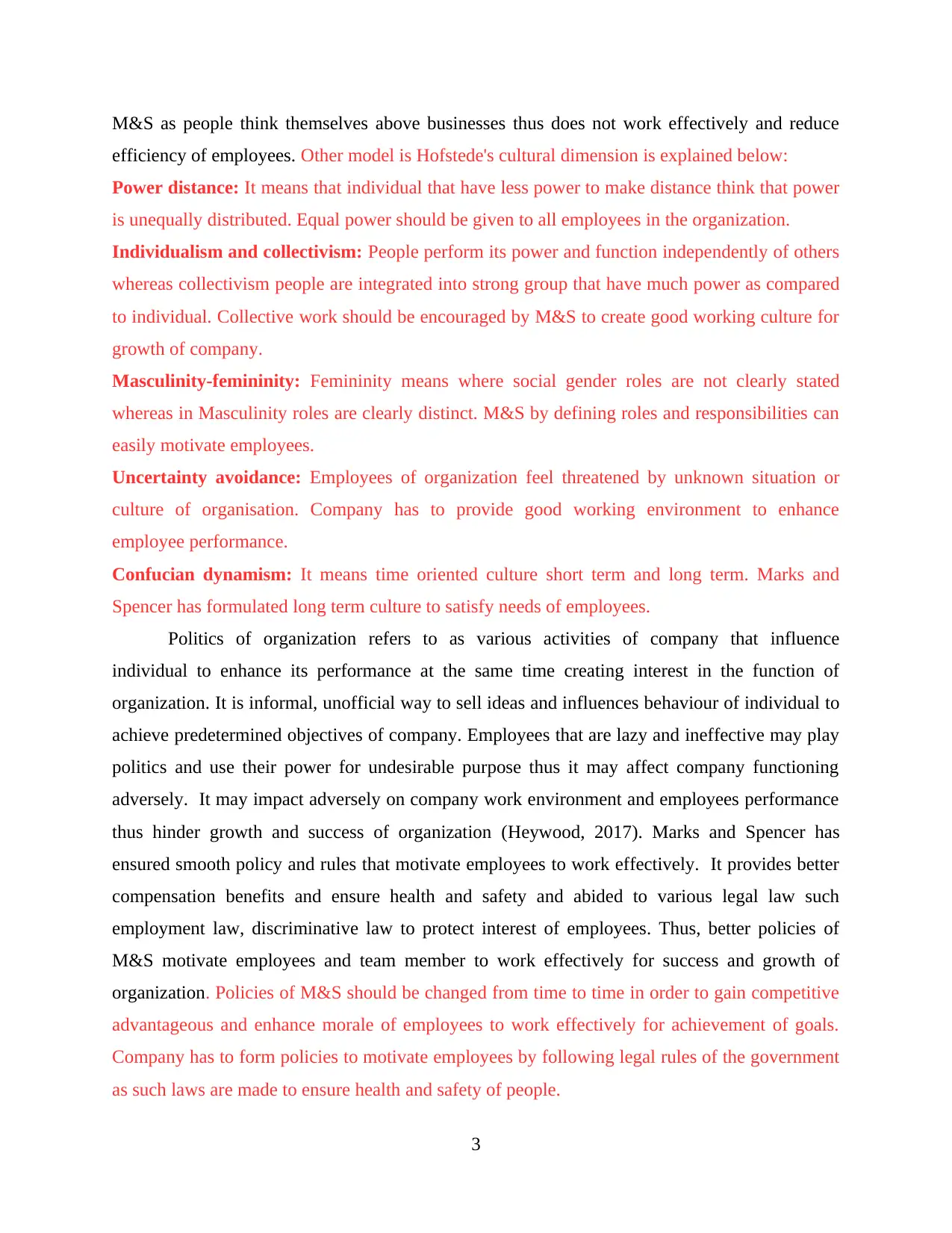
M&S as people think themselves above businesses thus does not work effectively and reduce
efficiency of employees. Other model is Hofstede's cultural dimension is explained below:
Power distance: It means that individual that have less power to make distance think that power
is unequally distributed. Equal power should be given to all employees in the organization.
Individualism and collectivism: People perform its power and function independently of others
whereas collectivism people are integrated into strong group that have much power as compared
to individual. Collective work should be encouraged by M&S to create good working culture for
growth of company.
Masculinity-femininity: Femininity means where social gender roles are not clearly stated
whereas in Masculinity roles are clearly distinct. M&S by defining roles and responsibilities can
easily motivate employees.
Uncertainty avoidance: Employees of organization feel threatened by unknown situation or
culture of organisation. Company has to provide good working environment to enhance
employee performance.
Confucian dynamism: It means time oriented culture short term and long term. Marks and
Spencer has formulated long term culture to satisfy needs of employees.
Politics of organization refers to as various activities of company that influence
individual to enhance its performance at the same time creating interest in the function of
organization. It is informal, unofficial way to sell ideas and influences behaviour of individual to
achieve predetermined objectives of company. Employees that are lazy and ineffective may play
politics and use their power for undesirable purpose thus it may affect company functioning
adversely. It may impact adversely on company work environment and employees performance
thus hinder growth and success of organization (Heywood, 2017). Marks and Spencer has
ensured smooth policy and rules that motivate employees to work effectively. It provides better
compensation benefits and ensure health and safety and abided to various legal law such
employment law, discriminative law to protect interest of employees. Thus, better policies of
M&S motivate employees and team member to work effectively for success and growth of
organization. Policies of M&S should be changed from time to time in order to gain competitive
advantageous and enhance morale of employees to work effectively for achievement of goals.
Company has to form policies to motivate employees by following legal rules of the government
as such laws are made to ensure health and safety of people.
3
efficiency of employees. Other model is Hofstede's cultural dimension is explained below:
Power distance: It means that individual that have less power to make distance think that power
is unequally distributed. Equal power should be given to all employees in the organization.
Individualism and collectivism: People perform its power and function independently of others
whereas collectivism people are integrated into strong group that have much power as compared
to individual. Collective work should be encouraged by M&S to create good working culture for
growth of company.
Masculinity-femininity: Femininity means where social gender roles are not clearly stated
whereas in Masculinity roles are clearly distinct. M&S by defining roles and responsibilities can
easily motivate employees.
Uncertainty avoidance: Employees of organization feel threatened by unknown situation or
culture of organisation. Company has to provide good working environment to enhance
employee performance.
Confucian dynamism: It means time oriented culture short term and long term. Marks and
Spencer has formulated long term culture to satisfy needs of employees.
Politics of organization refers to as various activities of company that influence
individual to enhance its performance at the same time creating interest in the function of
organization. It is informal, unofficial way to sell ideas and influences behaviour of individual to
achieve predetermined objectives of company. Employees that are lazy and ineffective may play
politics and use their power for undesirable purpose thus it may affect company functioning
adversely. It may impact adversely on company work environment and employees performance
thus hinder growth and success of organization (Heywood, 2017). Marks and Spencer has
ensured smooth policy and rules that motivate employees to work effectively. It provides better
compensation benefits and ensure health and safety and abided to various legal law such
employment law, discriminative law to protect interest of employees. Thus, better policies of
M&S motivate employees and team member to work effectively for success and growth of
organization. Policies of M&S should be changed from time to time in order to gain competitive
advantageous and enhance morale of employees to work effectively for achievement of goals.
Company has to form policies to motivate employees by following legal rules of the government
as such laws are made to ensure health and safety of people.
3
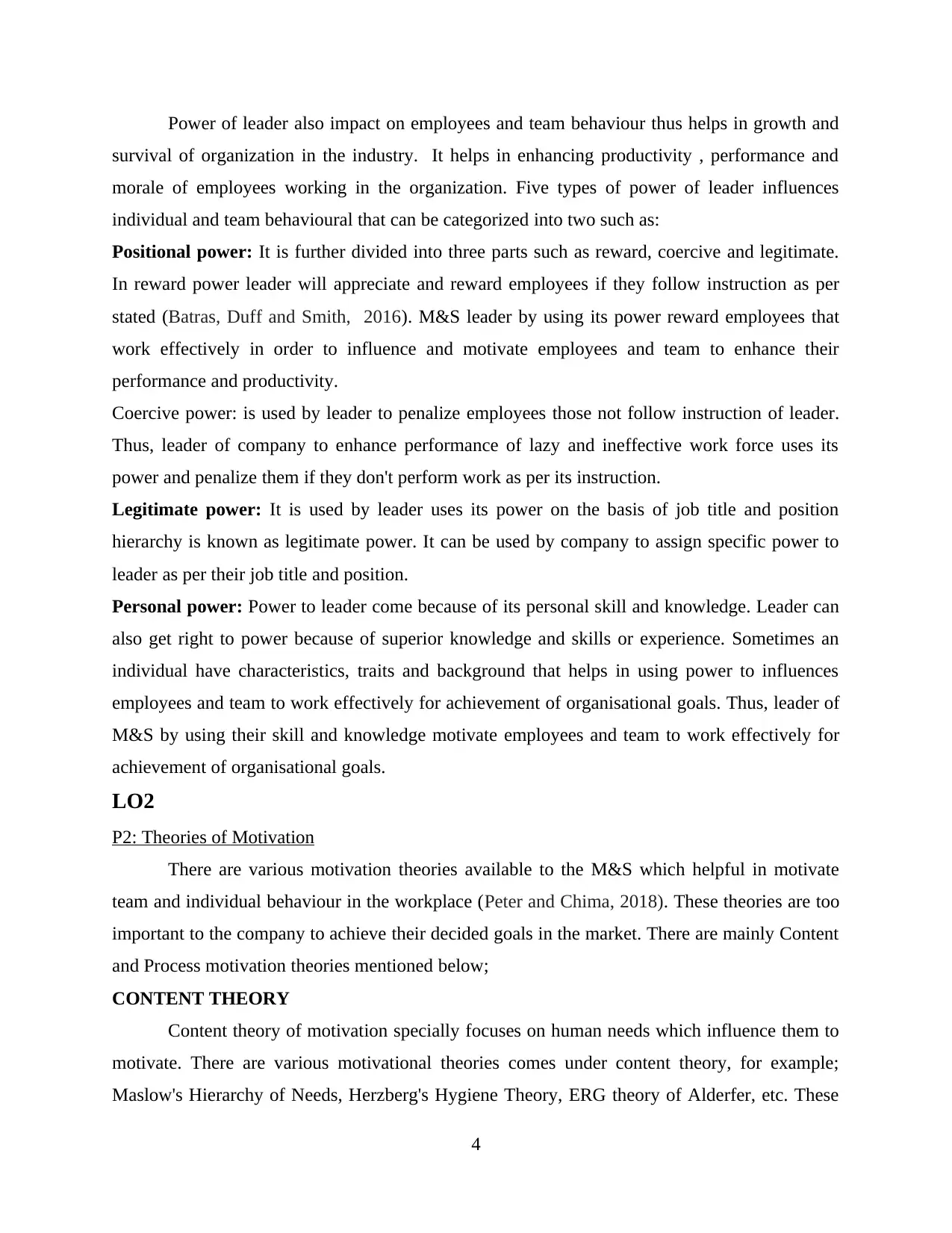
Power of leader also impact on employees and team behaviour thus helps in growth and
survival of organization in the industry. It helps in enhancing productivity , performance and
morale of employees working in the organization. Five types of power of leader influences
individual and team behavioural that can be categorized into two such as:
Positional power: It is further divided into three parts such as reward, coercive and legitimate.
In reward power leader will appreciate and reward employees if they follow instruction as per
stated (Batras, Duff and Smith, 2016). M&S leader by using its power reward employees that
work effectively in order to influence and motivate employees and team to enhance their
performance and productivity.
Coercive power: is used by leader to penalize employees those not follow instruction of leader.
Thus, leader of company to enhance performance of lazy and ineffective work force uses its
power and penalize them if they don't perform work as per its instruction.
Legitimate power: It is used by leader uses its power on the basis of job title and position
hierarchy is known as legitimate power. It can be used by company to assign specific power to
leader as per their job title and position.
Personal power: Power to leader come because of its personal skill and knowledge. Leader can
also get right to power because of superior knowledge and skills or experience. Sometimes an
individual have characteristics, traits and background that helps in using power to influences
employees and team to work effectively for achievement of organisational goals. Thus, leader of
M&S by using their skill and knowledge motivate employees and team to work effectively for
achievement of organisational goals.
LO2
P2: Theories of Motivation
There are various motivation theories available to the M&S which helpful in motivate
team and individual behaviour in the workplace (Peter and Chima, 2018). These theories are too
important to the company to achieve their decided goals in the market. There are mainly Content
and Process motivation theories mentioned below;
CONTENT THEORY
Content theory of motivation specially focuses on human needs which influence them to
motivate. There are various motivational theories comes under content theory, for example;
Maslow's Hierarchy of Needs, Herzberg's Hygiene Theory, ERG theory of Alderfer, etc. These
4
survival of organization in the industry. It helps in enhancing productivity , performance and
morale of employees working in the organization. Five types of power of leader influences
individual and team behavioural that can be categorized into two such as:
Positional power: It is further divided into three parts such as reward, coercive and legitimate.
In reward power leader will appreciate and reward employees if they follow instruction as per
stated (Batras, Duff and Smith, 2016). M&S leader by using its power reward employees that
work effectively in order to influence and motivate employees and team to enhance their
performance and productivity.
Coercive power: is used by leader to penalize employees those not follow instruction of leader.
Thus, leader of company to enhance performance of lazy and ineffective work force uses its
power and penalize them if they don't perform work as per its instruction.
Legitimate power: It is used by leader uses its power on the basis of job title and position
hierarchy is known as legitimate power. It can be used by company to assign specific power to
leader as per their job title and position.
Personal power: Power to leader come because of its personal skill and knowledge. Leader can
also get right to power because of superior knowledge and skills or experience. Sometimes an
individual have characteristics, traits and background that helps in using power to influences
employees and team to work effectively for achievement of organisational goals. Thus, leader of
M&S by using their skill and knowledge motivate employees and team to work effectively for
achievement of organisational goals.
LO2
P2: Theories of Motivation
There are various motivation theories available to the M&S which helpful in motivate
team and individual behaviour in the workplace (Peter and Chima, 2018). These theories are too
important to the company to achieve their decided goals in the market. There are mainly Content
and Process motivation theories mentioned below;
CONTENT THEORY
Content theory of motivation specially focuses on human needs which influence them to
motivate. There are various motivational theories comes under content theory, for example;
Maslow's Hierarchy of Needs, Herzberg's Hygiene Theory, ERG theory of Alderfer, etc. These
4
⊘ This is a preview!⊘
Do you want full access?
Subscribe today to unlock all pages.

Trusted by 1+ million students worldwide
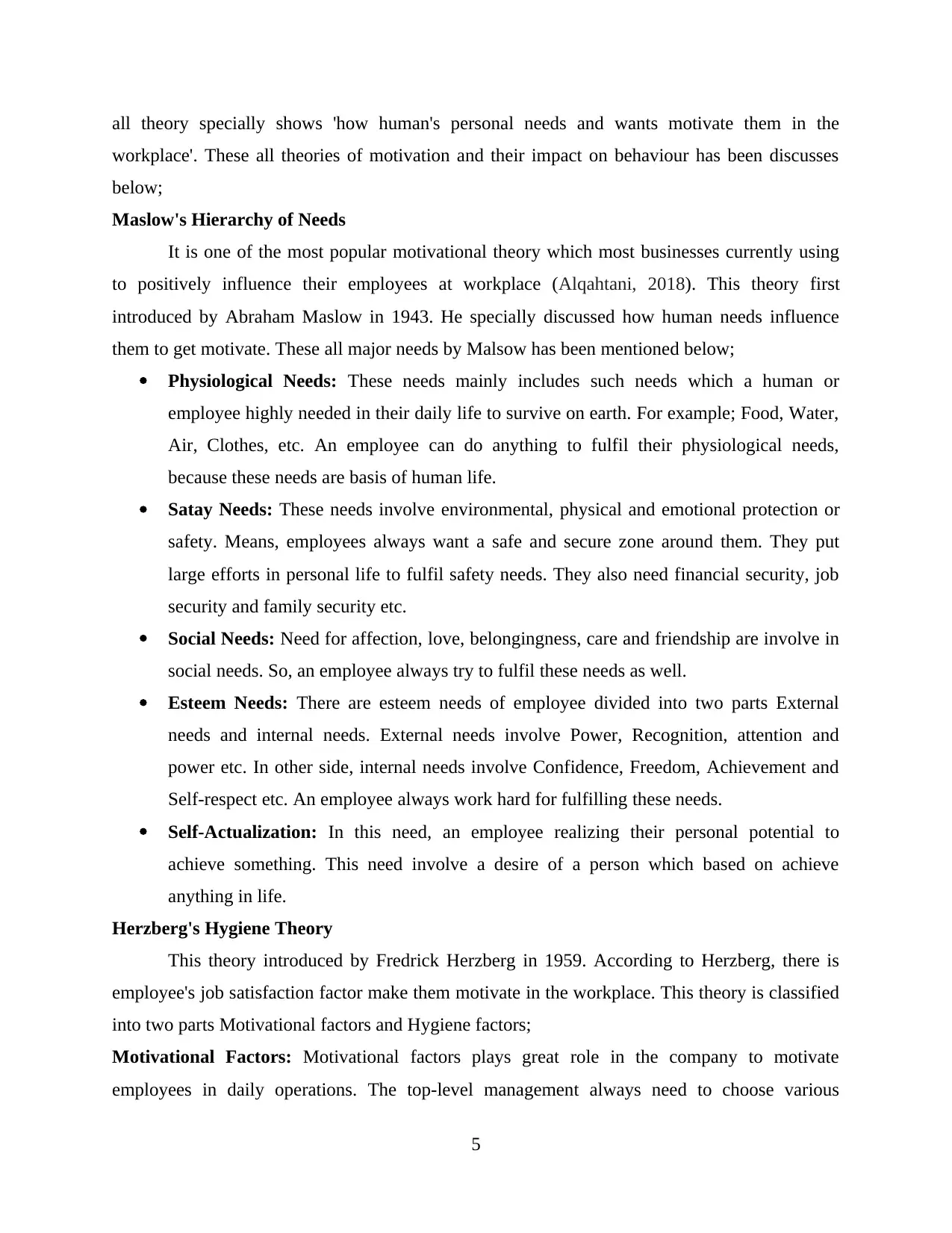
all theory specially shows 'how human's personal needs and wants motivate them in the
workplace'. These all theories of motivation and their impact on behaviour has been discusses
below;
Maslow's Hierarchy of Needs
It is one of the most popular motivational theory which most businesses currently using
to positively influence their employees at workplace (Alqahtani, 2018). This theory first
introduced by Abraham Maslow in 1943. He specially discussed how human needs influence
them to get motivate. These all major needs by Malsow has been mentioned below;
Physiological Needs: These needs mainly includes such needs which a human or
employee highly needed in their daily life to survive on earth. For example; Food, Water,
Air, Clothes, etc. An employee can do anything to fulfil their physiological needs,
because these needs are basis of human life.
Satay Needs: These needs involve environmental, physical and emotional protection or
safety. Means, employees always want a safe and secure zone around them. They put
large efforts in personal life to fulfil safety needs. They also need financial security, job
security and family security etc.
Social Needs: Need for affection, love, belongingness, care and friendship are involve in
social needs. So, an employee always try to fulfil these needs as well.
Esteem Needs: There are esteem needs of employee divided into two parts External
needs and internal needs. External needs involve Power, Recognition, attention and
power etc. In other side, internal needs involve Confidence, Freedom, Achievement and
Self-respect etc. An employee always work hard for fulfilling these needs.
Self-Actualization: In this need, an employee realizing their personal potential to
achieve something. This need involve a desire of a person which based on achieve
anything in life.
Herzberg's Hygiene Theory
This theory introduced by Fredrick Herzberg in 1959. According to Herzberg, there is
employee's job satisfaction factor make them motivate in the workplace. This theory is classified
into two parts Motivational factors and Hygiene factors;
Motivational Factors: Motivational factors plays great role in the company to motivate
employees in daily operations. The top-level management always need to choose various
5
workplace'. These all theories of motivation and their impact on behaviour has been discusses
below;
Maslow's Hierarchy of Needs
It is one of the most popular motivational theory which most businesses currently using
to positively influence their employees at workplace (Alqahtani, 2018). This theory first
introduced by Abraham Maslow in 1943. He specially discussed how human needs influence
them to get motivate. These all major needs by Malsow has been mentioned below;
Physiological Needs: These needs mainly includes such needs which a human or
employee highly needed in their daily life to survive on earth. For example; Food, Water,
Air, Clothes, etc. An employee can do anything to fulfil their physiological needs,
because these needs are basis of human life.
Satay Needs: These needs involve environmental, physical and emotional protection or
safety. Means, employees always want a safe and secure zone around them. They put
large efforts in personal life to fulfil safety needs. They also need financial security, job
security and family security etc.
Social Needs: Need for affection, love, belongingness, care and friendship are involve in
social needs. So, an employee always try to fulfil these needs as well.
Esteem Needs: There are esteem needs of employee divided into two parts External
needs and internal needs. External needs involve Power, Recognition, attention and
power etc. In other side, internal needs involve Confidence, Freedom, Achievement and
Self-respect etc. An employee always work hard for fulfilling these needs.
Self-Actualization: In this need, an employee realizing their personal potential to
achieve something. This need involve a desire of a person which based on achieve
anything in life.
Herzberg's Hygiene Theory
This theory introduced by Fredrick Herzberg in 1959. According to Herzberg, there is
employee's job satisfaction factor make them motivate in the workplace. This theory is classified
into two parts Motivational factors and Hygiene factors;
Motivational Factors: Motivational factors plays great role in the company to motivate
employees in daily operations. The top-level management always need to choose various
5
Paraphrase This Document
Need a fresh take? Get an instant paraphrase of this document with our AI Paraphraser
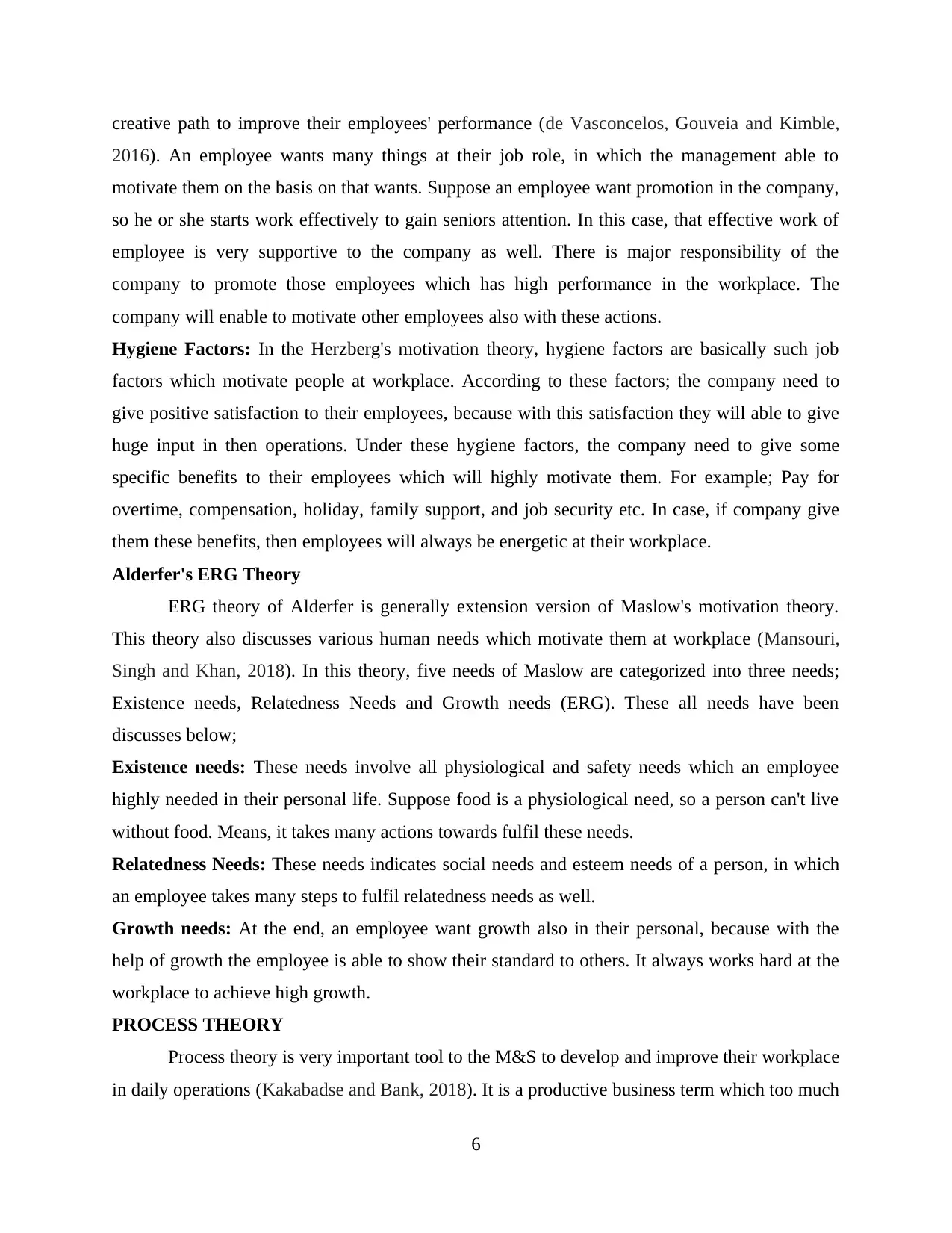
creative path to improve their employees' performance (de Vasconcelos, Gouveia and Kimble,
2016). An employee wants many things at their job role, in which the management able to
motivate them on the basis on that wants. Suppose an employee want promotion in the company,
so he or she starts work effectively to gain seniors attention. In this case, that effective work of
employee is very supportive to the company as well. There is major responsibility of the
company to promote those employees which has high performance in the workplace. The
company will enable to motivate other employees also with these actions.
Hygiene Factors: In the Herzberg's motivation theory, hygiene factors are basically such job
factors which motivate people at workplace. According to these factors; the company need to
give positive satisfaction to their employees, because with this satisfaction they will able to give
huge input in then operations. Under these hygiene factors, the company need to give some
specific benefits to their employees which will highly motivate them. For example; Pay for
overtime, compensation, holiday, family support, and job security etc. In case, if company give
them these benefits, then employees will always be energetic at their workplace.
Alderfer's ERG Theory
ERG theory of Alderfer is generally extension version of Maslow's motivation theory.
This theory also discusses various human needs which motivate them at workplace (Mansouri,
Singh and Khan, 2018). In this theory, five needs of Maslow are categorized into three needs;
Existence needs, Relatedness Needs and Growth needs (ERG). These all needs have been
discusses below;
Existence needs: These needs involve all physiological and safety needs which an employee
highly needed in their personal life. Suppose food is a physiological need, so a person can't live
without food. Means, it takes many actions towards fulfil these needs.
Relatedness Needs: These needs indicates social needs and esteem needs of a person, in which
an employee takes many steps to fulfil relatedness needs as well.
Growth needs: At the end, an employee want growth also in their personal, because with the
help of growth the employee is able to show their standard to others. It always works hard at the
workplace to achieve high growth.
PROCESS THEORY
Process theory is very important tool to the M&S to develop and improve their workplace
in daily operations (Kakabadse and Bank, 2018). It is a productive business term which too much
6
2016). An employee wants many things at their job role, in which the management able to
motivate them on the basis on that wants. Suppose an employee want promotion in the company,
so he or she starts work effectively to gain seniors attention. In this case, that effective work of
employee is very supportive to the company as well. There is major responsibility of the
company to promote those employees which has high performance in the workplace. The
company will enable to motivate other employees also with these actions.
Hygiene Factors: In the Herzberg's motivation theory, hygiene factors are basically such job
factors which motivate people at workplace. According to these factors; the company need to
give positive satisfaction to their employees, because with this satisfaction they will able to give
huge input in then operations. Under these hygiene factors, the company need to give some
specific benefits to their employees which will highly motivate them. For example; Pay for
overtime, compensation, holiday, family support, and job security etc. In case, if company give
them these benefits, then employees will always be energetic at their workplace.
Alderfer's ERG Theory
ERG theory of Alderfer is generally extension version of Maslow's motivation theory.
This theory also discusses various human needs which motivate them at workplace (Mansouri,
Singh and Khan, 2018). In this theory, five needs of Maslow are categorized into three needs;
Existence needs, Relatedness Needs and Growth needs (ERG). These all needs have been
discusses below;
Existence needs: These needs involve all physiological and safety needs which an employee
highly needed in their personal life. Suppose food is a physiological need, so a person can't live
without food. Means, it takes many actions towards fulfil these needs.
Relatedness Needs: These needs indicates social needs and esteem needs of a person, in which
an employee takes many steps to fulfil relatedness needs as well.
Growth needs: At the end, an employee want growth also in their personal, because with the
help of growth the employee is able to show their standard to others. It always works hard at the
workplace to achieve high growth.
PROCESS THEORY
Process theory is very important tool to the M&S to develop and improve their workplace
in daily operations (Kakabadse and Bank, 2018). It is a productive business term which too much
6
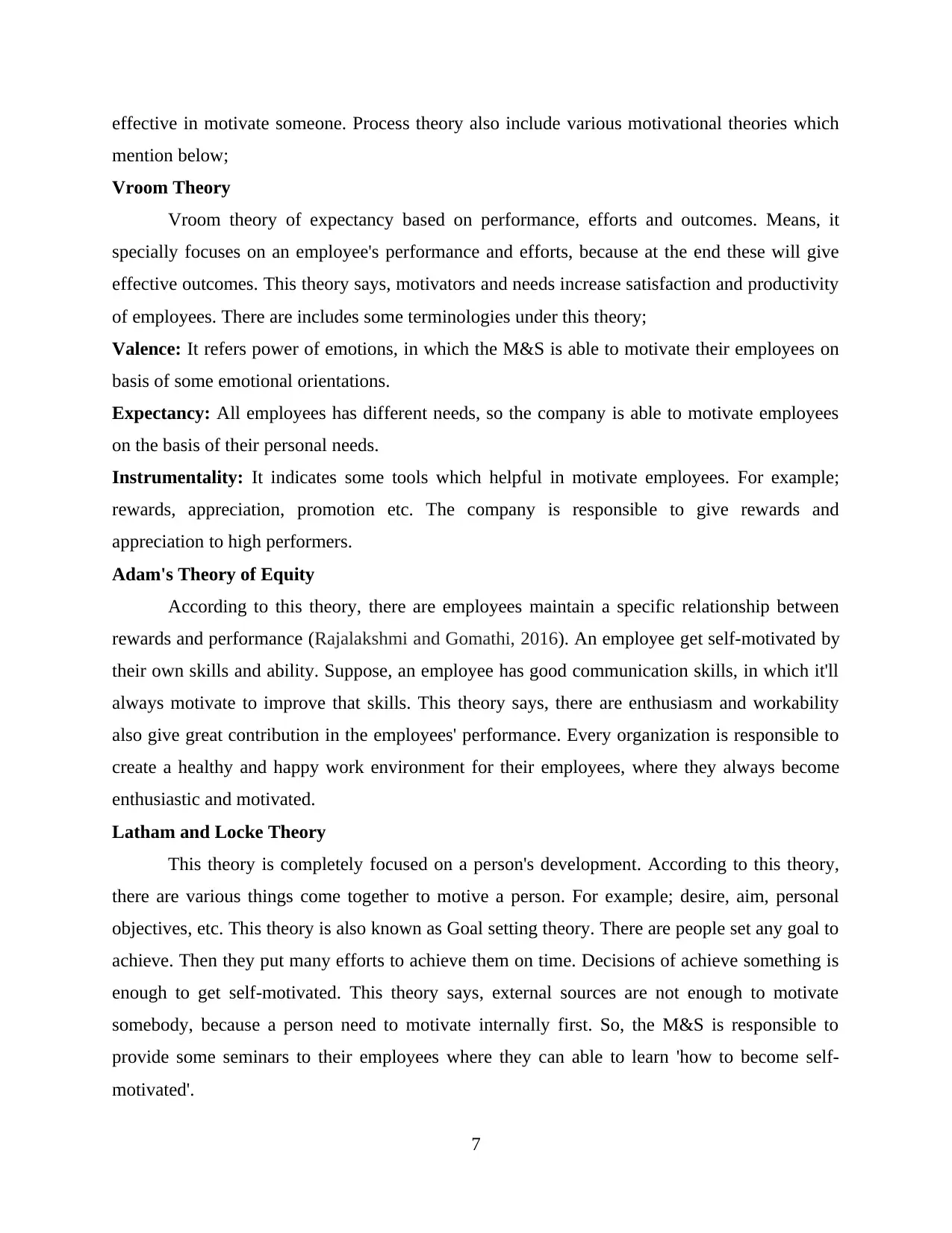
effective in motivate someone. Process theory also include various motivational theories which
mention below;
Vroom Theory
Vroom theory of expectancy based on performance, efforts and outcomes. Means, it
specially focuses on an employee's performance and efforts, because at the end these will give
effective outcomes. This theory says, motivators and needs increase satisfaction and productivity
of employees. There are includes some terminologies under this theory;
Valence: It refers power of emotions, in which the M&S is able to motivate their employees on
basis of some emotional orientations.
Expectancy: All employees has different needs, so the company is able to motivate employees
on the basis of their personal needs.
Instrumentality: It indicates some tools which helpful in motivate employees. For example;
rewards, appreciation, promotion etc. The company is responsible to give rewards and
appreciation to high performers.
Adam's Theory of Equity
According to this theory, there are employees maintain a specific relationship between
rewards and performance (Rajalakshmi and Gomathi, 2016). An employee get self-motivated by
their own skills and ability. Suppose, an employee has good communication skills, in which it'll
always motivate to improve that skills. This theory says, there are enthusiasm and workability
also give great contribution in the employees' performance. Every organization is responsible to
create a healthy and happy work environment for their employees, where they always become
enthusiastic and motivated.
Latham and Locke Theory
This theory is completely focused on a person's development. According to this theory,
there are various things come together to motive a person. For example; desire, aim, personal
objectives, etc. This theory is also known as Goal setting theory. There are people set any goal to
achieve. Then they put many efforts to achieve them on time. Decisions of achieve something is
enough to get self-motivated. This theory says, external sources are not enough to motivate
somebody, because a person need to motivate internally first. So, the M&S is responsible to
provide some seminars to their employees where they can able to learn 'how to become self-
motivated'.
7
mention below;
Vroom Theory
Vroom theory of expectancy based on performance, efforts and outcomes. Means, it
specially focuses on an employee's performance and efforts, because at the end these will give
effective outcomes. This theory says, motivators and needs increase satisfaction and productivity
of employees. There are includes some terminologies under this theory;
Valence: It refers power of emotions, in which the M&S is able to motivate their employees on
basis of some emotional orientations.
Expectancy: All employees has different needs, so the company is able to motivate employees
on the basis of their personal needs.
Instrumentality: It indicates some tools which helpful in motivate employees. For example;
rewards, appreciation, promotion etc. The company is responsible to give rewards and
appreciation to high performers.
Adam's Theory of Equity
According to this theory, there are employees maintain a specific relationship between
rewards and performance (Rajalakshmi and Gomathi, 2016). An employee get self-motivated by
their own skills and ability. Suppose, an employee has good communication skills, in which it'll
always motivate to improve that skills. This theory says, there are enthusiasm and workability
also give great contribution in the employees' performance. Every organization is responsible to
create a healthy and happy work environment for their employees, where they always become
enthusiastic and motivated.
Latham and Locke Theory
This theory is completely focused on a person's development. According to this theory,
there are various things come together to motive a person. For example; desire, aim, personal
objectives, etc. This theory is also known as Goal setting theory. There are people set any goal to
achieve. Then they put many efforts to achieve them on time. Decisions of achieve something is
enough to get self-motivated. This theory says, external sources are not enough to motivate
somebody, because a person need to motivate internally first. So, the M&S is responsible to
provide some seminars to their employees where they can able to learn 'how to become self-
motivated'.
7
⊘ This is a preview!⊘
Do you want full access?
Subscribe today to unlock all pages.

Trusted by 1+ million students worldwide
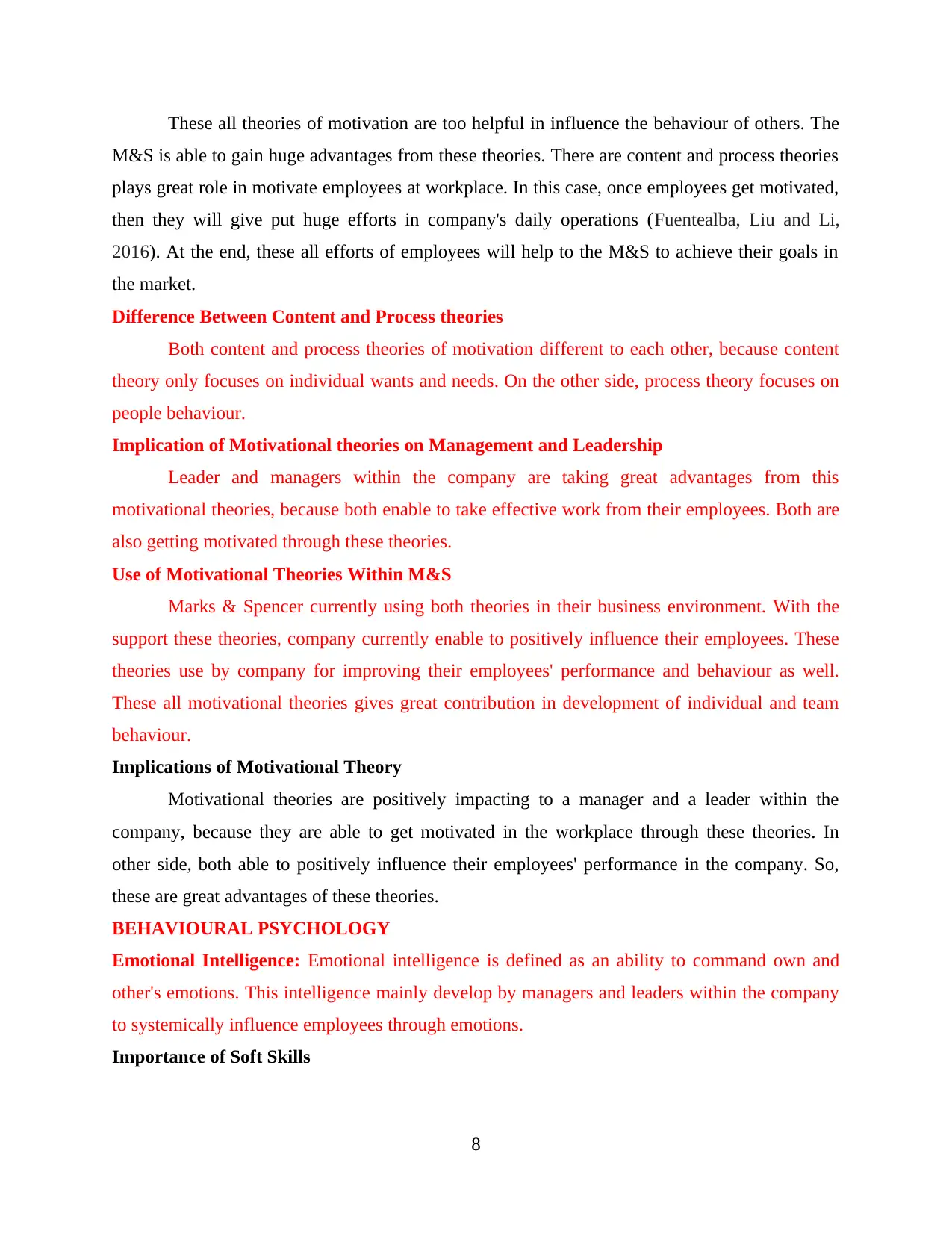
These all theories of motivation are too helpful in influence the behaviour of others. The
M&S is able to gain huge advantages from these theories. There are content and process theories
plays great role in motivate employees at workplace. In this case, once employees get motivated,
then they will give put huge efforts in company's daily operations (Fuentealba, Liu and Li,
2016). At the end, these all efforts of employees will help to the M&S to achieve their goals in
the market.
Difference Between Content and Process theories
Both content and process theories of motivation different to each other, because content
theory only focuses on individual wants and needs. On the other side, process theory focuses on
people behaviour.
Implication of Motivational theories on Management and Leadership
Leader and managers within the company are taking great advantages from this
motivational theories, because both enable to take effective work from their employees. Both are
also getting motivated through these theories.
Use of Motivational Theories Within M&S
Marks & Spencer currently using both theories in their business environment. With the
support these theories, company currently enable to positively influence their employees. These
theories use by company for improving their employees' performance and behaviour as well.
These all motivational theories gives great contribution in development of individual and team
behaviour.
Implications of Motivational Theory
Motivational theories are positively impacting to a manager and a leader within the
company, because they are able to get motivated in the workplace through these theories. In
other side, both able to positively influence their employees' performance in the company. So,
these are great advantages of these theories.
BEHAVIOURAL PSYCHOLOGY
Emotional Intelligence: Emotional intelligence is defined as an ability to command own and
other's emotions. This intelligence mainly develop by managers and leaders within the company
to systemically influence employees through emotions.
Importance of Soft Skills
8
M&S is able to gain huge advantages from these theories. There are content and process theories
plays great role in motivate employees at workplace. In this case, once employees get motivated,
then they will give put huge efforts in company's daily operations (Fuentealba, Liu and Li,
2016). At the end, these all efforts of employees will help to the M&S to achieve their goals in
the market.
Difference Between Content and Process theories
Both content and process theories of motivation different to each other, because content
theory only focuses on individual wants and needs. On the other side, process theory focuses on
people behaviour.
Implication of Motivational theories on Management and Leadership
Leader and managers within the company are taking great advantages from this
motivational theories, because both enable to take effective work from their employees. Both are
also getting motivated through these theories.
Use of Motivational Theories Within M&S
Marks & Spencer currently using both theories in their business environment. With the
support these theories, company currently enable to positively influence their employees. These
theories use by company for improving their employees' performance and behaviour as well.
These all motivational theories gives great contribution in development of individual and team
behaviour.
Implications of Motivational Theory
Motivational theories are positively impacting to a manager and a leader within the
company, because they are able to get motivated in the workplace through these theories. In
other side, both able to positively influence their employees' performance in the company. So,
these are great advantages of these theories.
BEHAVIOURAL PSYCHOLOGY
Emotional Intelligence: Emotional intelligence is defined as an ability to command own and
other's emotions. This intelligence mainly develop by managers and leaders within the company
to systemically influence employees through emotions.
Importance of Soft Skills
8
Paraphrase This Document
Need a fresh take? Get an instant paraphrase of this document with our AI Paraphraser
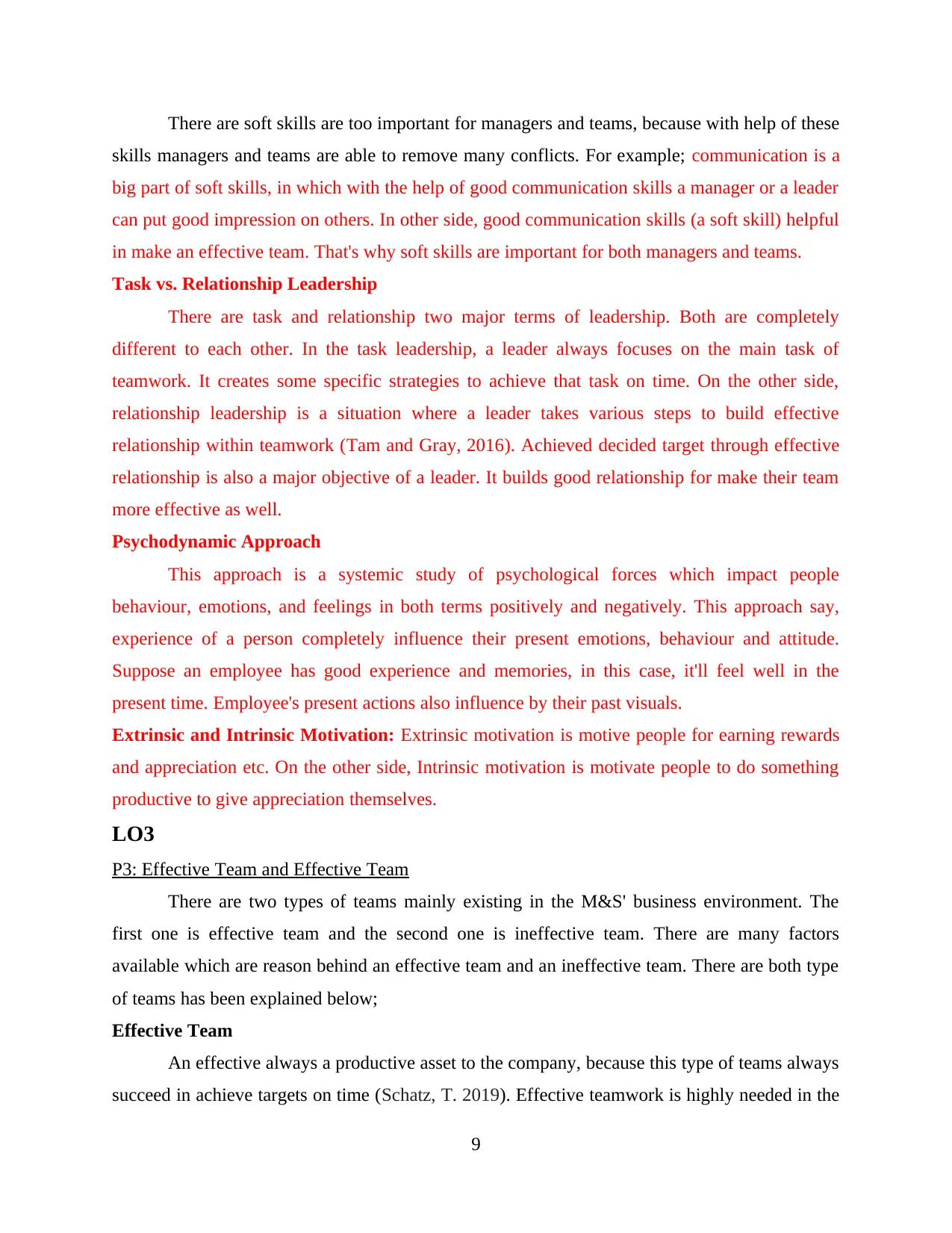
There are soft skills are too important for managers and teams, because with help of these
skills managers and teams are able to remove many conflicts. For example; communication is a
big part of soft skills, in which with the help of good communication skills a manager or a leader
can put good impression on others. In other side, good communication skills (a soft skill) helpful
in make an effective team. That's why soft skills are important for both managers and teams.
Task vs. Relationship Leadership
There are task and relationship two major terms of leadership. Both are completely
different to each other. In the task leadership, a leader always focuses on the main task of
teamwork. It creates some specific strategies to achieve that task on time. On the other side,
relationship leadership is a situation where a leader takes various steps to build effective
relationship within teamwork (Tam and Gray, 2016). Achieved decided target through effective
relationship is also a major objective of a leader. It builds good relationship for make their team
more effective as well.
Psychodynamic Approach
This approach is a systemic study of psychological forces which impact people
behaviour, emotions, and feelings in both terms positively and negatively. This approach say,
experience of a person completely influence their present emotions, behaviour and attitude.
Suppose an employee has good experience and memories, in this case, it'll feel well in the
present time. Employee's present actions also influence by their past visuals.
Extrinsic and Intrinsic Motivation: Extrinsic motivation is motive people for earning rewards
and appreciation etc. On the other side, Intrinsic motivation is motivate people to do something
productive to give appreciation themselves.
LO3
P3: Effective Team and Effective Team
There are two types of teams mainly existing in the M&S' business environment. The
first one is effective team and the second one is ineffective team. There are many factors
available which are reason behind an effective team and an ineffective team. There are both type
of teams has been explained below;
Effective Team
An effective always a productive asset to the company, because this type of teams always
succeed in achieve targets on time (Schatz, T. 2019). Effective teamwork is highly needed in the
9
skills managers and teams are able to remove many conflicts. For example; communication is a
big part of soft skills, in which with the help of good communication skills a manager or a leader
can put good impression on others. In other side, good communication skills (a soft skill) helpful
in make an effective team. That's why soft skills are important for both managers and teams.
Task vs. Relationship Leadership
There are task and relationship two major terms of leadership. Both are completely
different to each other. In the task leadership, a leader always focuses on the main task of
teamwork. It creates some specific strategies to achieve that task on time. On the other side,
relationship leadership is a situation where a leader takes various steps to build effective
relationship within teamwork (Tam and Gray, 2016). Achieved decided target through effective
relationship is also a major objective of a leader. It builds good relationship for make their team
more effective as well.
Psychodynamic Approach
This approach is a systemic study of psychological forces which impact people
behaviour, emotions, and feelings in both terms positively and negatively. This approach say,
experience of a person completely influence their present emotions, behaviour and attitude.
Suppose an employee has good experience and memories, in this case, it'll feel well in the
present time. Employee's present actions also influence by their past visuals.
Extrinsic and Intrinsic Motivation: Extrinsic motivation is motive people for earning rewards
and appreciation etc. On the other side, Intrinsic motivation is motivate people to do something
productive to give appreciation themselves.
LO3
P3: Effective Team and Effective Team
There are two types of teams mainly existing in the M&S' business environment. The
first one is effective team and the second one is ineffective team. There are many factors
available which are reason behind an effective team and an ineffective team. There are both type
of teams has been explained below;
Effective Team
An effective always a productive asset to the company, because this type of teams always
succeed in achieve targets on time (Schatz, T. 2019). Effective teamwork is highly needed in the
9
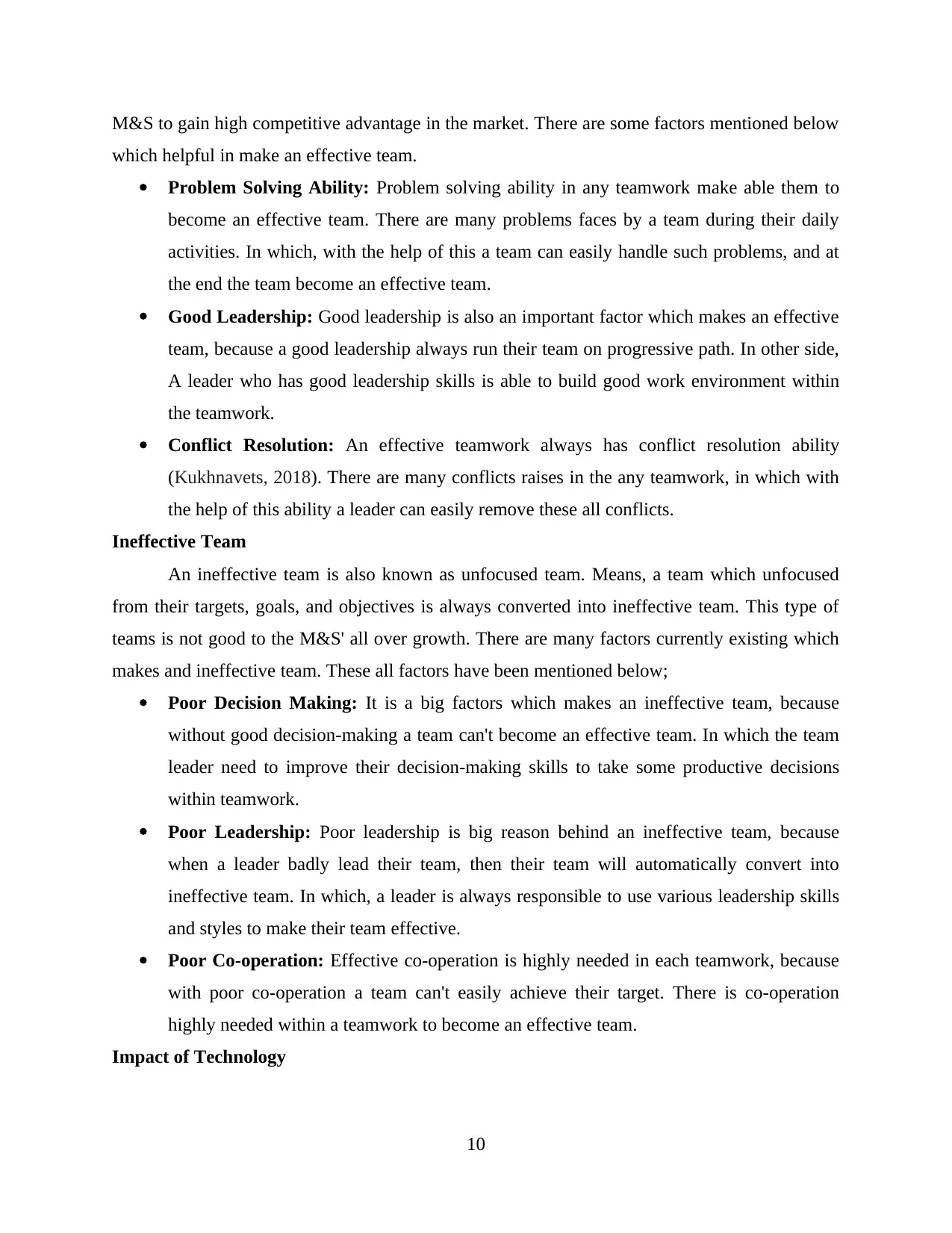
M&S to gain high competitive advantage in the market. There are some factors mentioned below
which helpful in make an effective team.
Problem Solving Ability: Problem solving ability in any teamwork make able them to
become an effective team. There are many problems faces by a team during their daily
activities. In which, with the help of this a team can easily handle such problems, and at
the end the team become an effective team.
Good Leadership: Good leadership is also an important factor which makes an effective
team, because a good leadership always run their team on progressive path. In other side,
A leader who has good leadership skills is able to build good work environment within
the teamwork.
Conflict Resolution: An effective teamwork always has conflict resolution ability
(Kukhnavets, 2018). There are many conflicts raises in the any teamwork, in which with
the help of this ability a leader can easily remove these all conflicts.
Ineffective Team
An ineffective team is also known as unfocused team. Means, a team which unfocused
from their targets, goals, and objectives is always converted into ineffective team. This type of
teams is not good to the M&S' all over growth. There are many factors currently existing which
makes and ineffective team. These all factors have been mentioned below;
Poor Decision Making: It is a big factors which makes an ineffective team, because
without good decision-making a team can't become an effective team. In which the team
leader need to improve their decision-making skills to take some productive decisions
within teamwork.
Poor Leadership: Poor leadership is big reason behind an ineffective team, because
when a leader badly lead their team, then their team will automatically convert into
ineffective team. In which, a leader is always responsible to use various leadership skills
and styles to make their team effective.
Poor Co-operation: Effective co-operation is highly needed in each teamwork, because
with poor co-operation a team can't easily achieve their target. There is co-operation
highly needed within a teamwork to become an effective team.
Impact of Technology
10
which helpful in make an effective team.
Problem Solving Ability: Problem solving ability in any teamwork make able them to
become an effective team. There are many problems faces by a team during their daily
activities. In which, with the help of this a team can easily handle such problems, and at
the end the team become an effective team.
Good Leadership: Good leadership is also an important factor which makes an effective
team, because a good leadership always run their team on progressive path. In other side,
A leader who has good leadership skills is able to build good work environment within
the teamwork.
Conflict Resolution: An effective teamwork always has conflict resolution ability
(Kukhnavets, 2018). There are many conflicts raises in the any teamwork, in which with
the help of this ability a leader can easily remove these all conflicts.
Ineffective Team
An ineffective team is also known as unfocused team. Means, a team which unfocused
from their targets, goals, and objectives is always converted into ineffective team. This type of
teams is not good to the M&S' all over growth. There are many factors currently existing which
makes and ineffective team. These all factors have been mentioned below;
Poor Decision Making: It is a big factors which makes an ineffective team, because
without good decision-making a team can't become an effective team. In which the team
leader need to improve their decision-making skills to take some productive decisions
within teamwork.
Poor Leadership: Poor leadership is big reason behind an ineffective team, because
when a leader badly lead their team, then their team will automatically convert into
ineffective team. In which, a leader is always responsible to use various leadership skills
and styles to make their team effective.
Poor Co-operation: Effective co-operation is highly needed in each teamwork, because
with poor co-operation a team can't easily achieve their target. There is co-operation
highly needed within a teamwork to become an effective team.
Impact of Technology
10
⊘ This is a preview!⊘
Do you want full access?
Subscribe today to unlock all pages.

Trusted by 1+ million students worldwide
1 out of 17
Related Documents
Your All-in-One AI-Powered Toolkit for Academic Success.
+13062052269
info@desklib.com
Available 24*7 on WhatsApp / Email
![[object Object]](/_next/static/media/star-bottom.7253800d.svg)
Unlock your academic potential
Copyright © 2020–2025 A2Z Services. All Rights Reserved. Developed and managed by ZUCOL.




